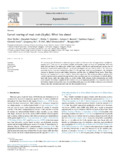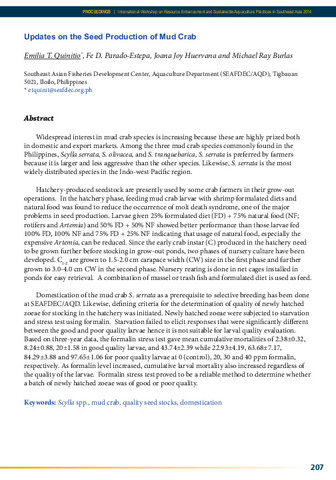Transport of Scylla serrata megalopae at various densities and durations
Share
| dc.contributor.author | Quinito, Emilia T. | |
| dc.contributor.author | Parado-Estepa, Fe D. | |
| dc.date.accessioned | 2014-01-13T07:03:05Z | |
| dc.date.available | 2014-01-13T07:03:05Z | |
| dc.date.issued | 2000 | |
| dc.identifier.citation | Quinitio, E. T., & Parado-Estepa, F. D. (2000). Transport of Scylla serrata megalopae at various densities and durations. Aquaculture, 185(1-2), 63-71. | en |
| dc.identifier.issn | 0044-8486 | |
| dc.identifier.uri | http://hdl.handle.net/10862/1884 | |
| dc.description.abstract | The optimal conditions for transport of Scylla serrata megalopae were determined. Loading densities of 50, 100 and 150 ind l−1 of hatchery-reared megalopae were studied over a 6-h simulated transport, including shaking. Survival immediately after transport was significantly higher at 50 ind l−1 (99.3±1.6%) (mean±x%) than at 100 (93.0±5.0) and 150 ind l−1 (94.0±3.8%). The same trend was noted 15 h after transport. Another experiment compared survival of megalopae packed at 50 and 100 ind l−1 with simulated transport of various durations (3, 6, and 9 h) at mobile and stationary conditions. Regardless of the duration and condition of transport, survival was again significantly higher at 50 ind l−1 (86.7±2.4%) compared to 100 ind l−1 (79.7±2.1%). Megalopae that were shaken or remained unshaken for 3 or 6 h had similar survival through transport as those shaken for 9 h. Megalopae that remained unshaken for 9 h gave the lowest survival among treatment groups (38.7±0.2%). Due to cannibalistic behavior, stationary transport conditions may have provided the megalopae with a chance to grasp each other. In a third experiment, a batch of megalopae was packed at water temperature levels of 20, 24, and 28°C (ambient) at 50 and 100 ind l−1 for 6 h simulated transport, including shaking. Density and temperature separately influenced survival. Survival was lower at 28°C than 24°C. Although megalopae were less active at 20°C, survival was similar to that at 24°C and 28°C. These results provide useful information for megalopae transport from hatchery to ponds. | en |
| dc.description.sponsorship | This study was partly funded by the Australian Centre for Agricultural Research (ACIAR) under Project No. 9217. | en |
| dc.language.iso | en | en |
| dc.publisher | Elsevier | en |
| dc.subject | Scylla serrata | en |
| dc.subject | Mud crab | en |
| dc.title | Transport of Scylla serrata megalopae at various densities and durations | en |
| dc.type | Article | en |
| dc.citation.volume | 185 | |
| dc.citation.issue | 1-2 | |
| dc.citation.spage | 63 | |
| dc.citation.epage | 71 | |
| dc.citation.journalTitle | Aquaculture | en |
| dc.subject.asfa | crab culture | en |
| dc.subject.asfa | developmental stages | en |
| dc.subject.asfa | larval stage | en |
| dc.subject.asfa | survival | en |
| dc.subject.asfa | transport | en |
| dc.subject.asfa | density | en |
| dc.subject.asfa | Megalops | en |
| dc.identifier.doi | 10.1016/S0044-8486(99)00334-8 | |
| dc.subject.scientificName | Scylla serrata | en |
Files in this item
| Files | Size | Format | View |
|---|
This item appears in the following Collection(s)
-
AQD Journal Articles [1248]
These papers were contributed by AQD staff to various national and international journals



